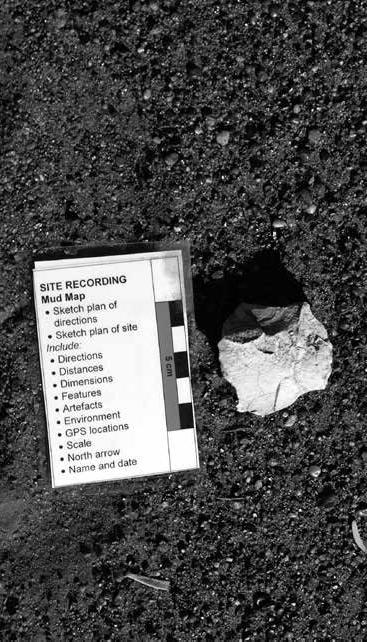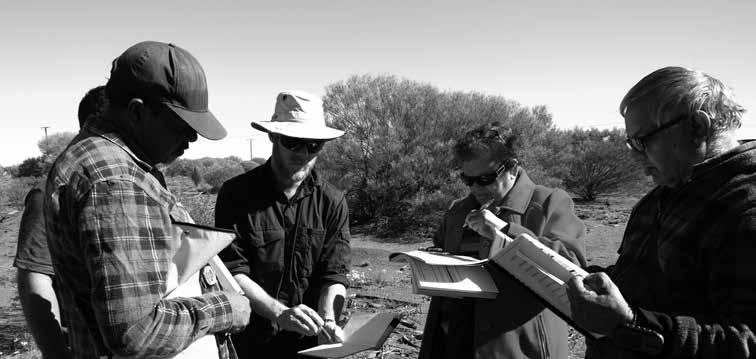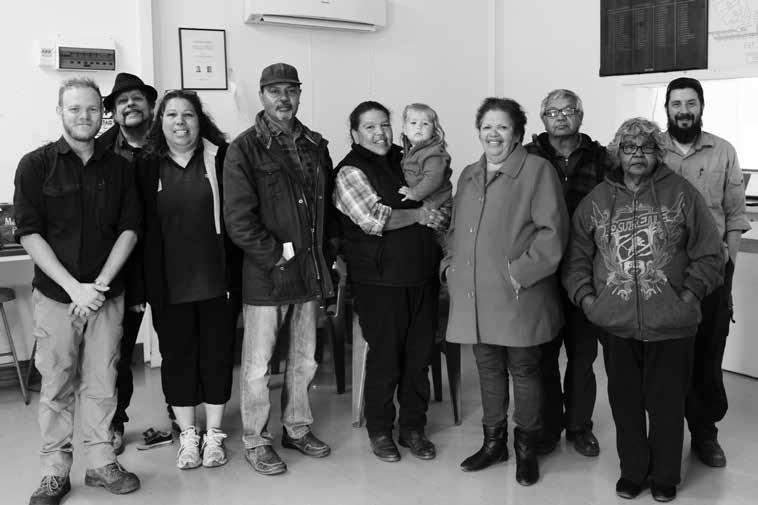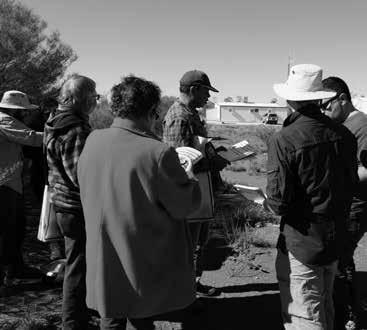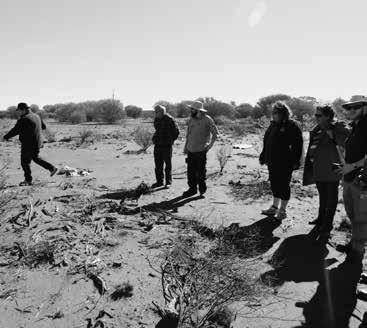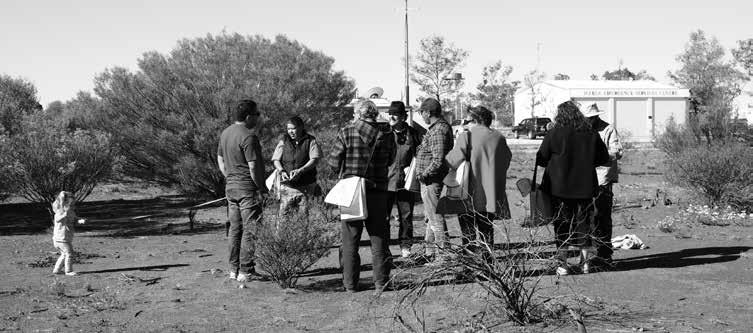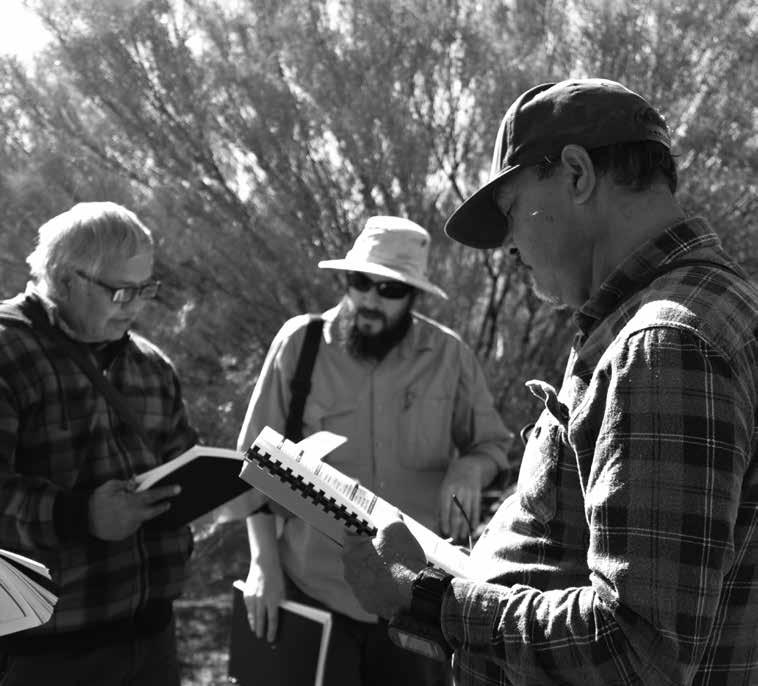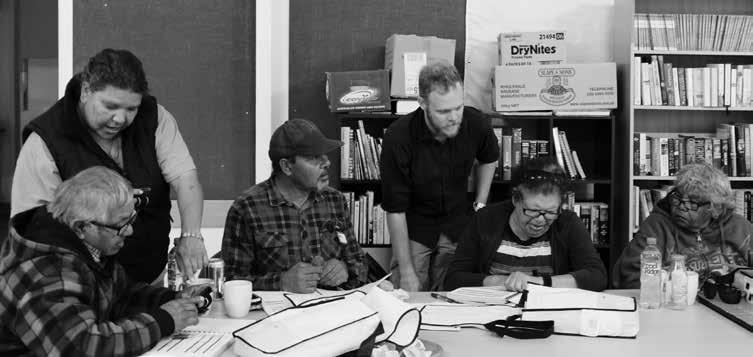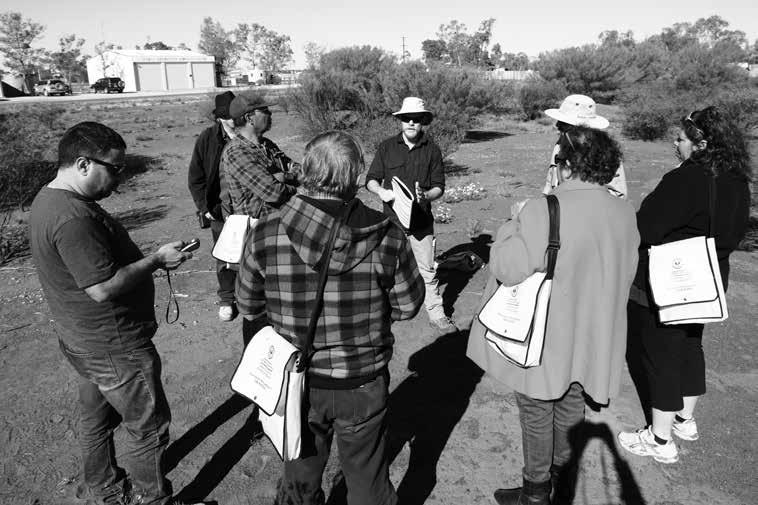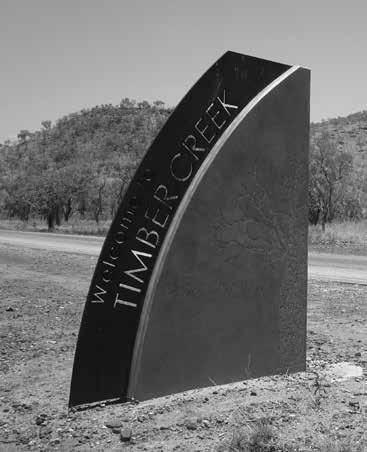
17 minute read
Inside: New voice for native title groups across SA
“And then they will look at building a deep underground facility somewhere, but there is a 17-year gap at least between the time the waste is actually on our soil and it starts getting buried and knowing that, looking around the world in terms of what happens on the nuclear industry, that is likely to be, the industry is replete with time blow outs, cost blow outs, it is likely to be longer than that. And that is a level of risk which is not being made clear to the South Australian Community. We will actually be storing this waste above ground near our coast, and one of the biggest concerns there is ultimately if we actually don’t manage to build that underground site – what happens then? What is the Plan B?” said Mr Wilkins.
Mr Wilkins said that international experience shows that building a long-term high-level nuclear waste dump is extremely difficult – there is not one currently fully operating anywhere in the world. “Because if you look around the world in the last seventy years not one country has successfully shown they can manage a deep underground nuclear waste facility. Finland is probably getting closest, but their site is still being built. It actually hasn’t even been opened yet, and it hasn’t received any of the waste yet. That won’t happen for five, six, seven years. So they’ve got a concept plan, but they haven’t got a track record.” “The only deep level underground waste repository anywhere in the world for nuclear waste was in New Mexico in the US, they operated for about 15 years. Initially it was regarded as the best possible option, they got the community onside, they made sure they had the best technology and everything was going well for the first few years, but about 15 years in a combination of human error and slackening of safety meant that there was a fire, followed by an unrelated explosion, workers were exposed, the plant was shut down, it’s still shut down and the clean-up bill is estimated to be at least half a billion dollars,” he said. Mr Wilkins said that this experience shows the scale of the challenge for South Australia to safely store high-level nuclear waste.
Advertisement
“That’s in a country which has a long and detailed history of nuclear management. Australia doesn’t. We are starting from scratch. And that’s why in terms of this push for maximum safety we would have to invest a huge amount of money to be confident we could do it and even then we won’t know if we can do it until we actually do it ourselves. Because of our particular geology, and the particular challenges in the locality,” he said. Jason Downs, Leader, Nuclear Engagement Process, recently told the Paper Tracker Radio Show the next steps towards the decision making on the nuclear proposal. “The final stage will be a second Citizen’s Jury of 350 people that will take all of the feedback on board from the people that we’ve spoken with, all of the information from the first jury and all of the feedback that’s come from social media and they will provide a report back to the Premier,” he said.
A decision by the Premier is expected by the end of 2016.
Premier says nuclear dumps ‘won’t be forced on Aboriginal people’
The ABC’s Q&A program visited Adelaide in September, and Karina Lester, Chair of Yankunytjatjara Native Title Aboriginal Corporation spoke up for Aboriginal people by asking the Premier a question on the current nuclear waste dump proposal. Karina Lester
You have said that consent of Traditional Owners is essential before a nuclear waste dump would be considered. Yet ever since the Royal Commission first proposed a dump, a majority of Aboriginal people have consistently said ‘no’. Despite that, your Government has proceeded to push ahead with a rushed, insensitive and culturally inappropriate consultation process. How will you and your Government measure our consensus, and when will our voices be heard and respected? Premier Weatherill
Thank you Karina and I know this is obviously a profoundly important issue for you and your community, especially your father who is so much an important campaigner for Aboriginal rights, and in particular for his people in the North West of our state, in the APY Lands. Can I say that from the outset, the Royal Commission identified that a critical element of this is community consent, and he described the consent in two ways, one is social consent – the whole community, the whole South Australian community, but then, in terms of a place for a location for a facility, if one were to exist, it would need specific community consent. And that would require specifically the explicit consent of Traditional Owners. Now if that didn’t exist, it won’t happen. That’s the experience in Finland, essentially a capacity for community consent was built into their process and what that gave them was a sense of comfort that this thing wasn’t going to happen unless they agreed to it. We have been travelling across the state, we’ve reached out to every community, we have a consultative committee that sits on top of this that’s led by former Federal Court Judge Justice Mansfield who is a wellrespected judge, who’s played a big role in Native Title places, we have Parry Agius, an Aboriginal man who’s helping us design our engagement with Aboriginal people. And we’re trying to reach out. If we’ve been ineffective in doing that, we’ll have to try harder. But this process is not going to finish quickly, it’s going to be an ongoing process and we have to deeply engage with Aboriginal people and ultimately nothing’s going to be forced on Aboriginal people. Tony Jones
Is there a way of offering financial incentives to the Indigenous community? Premier Weatherill
Of course, that would be a necessary part of this, but there’s a pre-condition for some communities, whatever the money was, whatever the financial benefits were, they would say ‘no’. We first need to grapple with that. But there would be profound benefits for communities, that’s what we saw in Finland, very great opportunities for financial benefits which provide services and opportunities for people. Karina Lester
Yes, the question was that you are now pushing to the Citizen’s Jury number 2, so you’re on a timeline, November is when you’re hoping to have that final report by the end of that consultation process. That doesn’t give people time to really understand and digest that, so you are not allowing for that conversation and discussion to happen. So Anangu, Aboriginal people have said no, and consistently say no to this. Because the location of this, if it was going to go ahead, is not going to be here in Adelaide, it’s going to be north of Port Augusta, which is going to impact on Anangu tjuta, and Aboriginal people from that north area right up to the top of the state. Premier Weatherill
Well maybe and maybe not, Karina, I mean the site hasn’t been chosen and can I say that the point of the Citizen’s Jury and also the consultation, which are probably more important, going out and speaking to people, was to gather perspectives. So that second Citizen’s Jury will bring your perspective into the process and that will be profoundly important for the next steps we take. No decisions, no quick decisions are going to be taken, we will take a preliminary view of things by the end of the year, but that will largely be a decision about whether to say ‘no, we’re not interested at all’ or a decision to take a further extensive period of discussion. Look Finland took 38 years, it’s not going to happen any time soon, if it happens at all.
New voice for native title groups across SA
Traditional Owners in South Australia may soon have a new way to have their views heard, with a statewide body to represent Native Title holders on issues of state significance under discussion.
The new organisation would replace The Aboriginal Congress of South Australia (Congress), which has represented Native Title groups since August 2007. The decision to form a new organisation follows limited activity by Congress in recent times due to organisational and funding pressures. Keith Thomas, CEO of SA Native Title Services said that the group could play an important role in South Australia.
“My discussions with native title groups over recent times has reinforced both the desire and the need for a statewide representative organisation for native title groups,” he said. The new body would focus on issues of state significance, providing one coherent voice for native title communities.
“The changes to the Aboriginal Heritage Act, the Nuclear Fuel Cycle Royal Commission and State Government consultations, and other statewide issues have also clearly demonstrated the need for a representative group,” Mr Thomas said.
At a meeting in Port Augusta on 14 August 2016, which all native title groups in South Australia were invited to attend, the way to provide a voice for Traditional Owners was discussed.
It was proposed that membership would be open to all native title groups in South Australia, with one member representing each native title community. To use the limited resources available effectively, it was proposed that an executive would be elected to meet regularly and make decisions and set policy. The Port Augusta forum was attended by representatives from some 18 native title groups. Positive discussions were held and there was overwhelming support for establishing a new statwide body. A working group was established to progress the development of a new body. Members of the Working Group recently met to progress the key points discussed at the initial meeting. A number of objectives and purposes of the statewide body were presented, discussed and refined to determine the direction and role of a united voice within South Australia to promote sustainable outcomes for native title claimants within South Australia.
Feedback and comments are currently being sought from the other working group members on the issues discussed at the meeting. The working group will meet soon to finalise the actions from the meeting and continue to progress the formation of the statewide body.
Borroloola Native Title Group granted the right to trade over township
On 1 July 2016, the Federal Court handed down a significant native title determination in the Northern Territory. The Northern Land Council successfully argued on behalf of the Rrumburriya Borroloola claim group, that traditional owners living in the area had historically practiced commerce with Macassan traders from Indonesia.
Prior to Sovereignty, Macassan trapangers (sea-cucumber harvesters) came annually from the Celebes to northern Australia and islands. They needed access to capture, cook and cure trepang. They needed firewood and they took away with them resources from land and sea including pearl and tortoise shell. In exchange, Macassans provided the Rrumburriya Borroloola People with high value items i.e. dugout canoes, steel axes, iron for harpoon tips, rice, tobacco and Arrack rum.
During the Federal Court hearing, material was presented showing evidence this type of trading existed prior to British settlement. Justice Mansfield said in his judgement, that the dealings with the Macassans were described as transactions of a commercial kind and that the Macassan visitation to the Gulf country dated from at least 1780.
The native title determination gives the Borroloola people the right to continue the historic practice of trade activities over their native title claim area.
This is the first determination of this kind in the Northern Territory and native title lawyers are now looking at how this will impact other native title claims across the country. Osker Linde, South Australian Native Title Services Deputy Principal Legal Officer said that the determination demonstrates how native title rights can be recognised more broadly and include complex uses for the land.
“The judgment should be analysed by lawyers briefing Anthropologists to provide expert evidence in native title claims.” “It is safe to say that this type of activity was happening across Australia prior to European settlement within Aboriginal societies.”
This case opens up opportunities for other native title groups claiming rights to be recognised without limitation as to purpose. Old claims may need to revisit their rights claimed based on the findings of this recent decision,” said Mr Linde.
Joe Morrison, CEO of Northern Land Council said Justice Mansfield’s judgement was an important document for those interested in Aboriginal history and culture.
“The court ’s decision is an important read for those interested in the history of the laws and customs of the Aboriginal people that belong to this country. It is also an important fact of life for the Northern Territory and the nation itself to recognise the long standing commercial trade that took place long before the arrival of the British to Australia.”
Mr Morrison praised Justice Mansfield for his decision and honoured his longstanding work in formally recognising Aboriginal connections to country. “In every case His Honour (Justice Mansfield) has demonstrated a profound understanding of Aboriginal law and custom, the connection of people to land and how colonisation and government policies have affected them.” He brought that wisdom to the Borroloola claim which has brought us here today,” said Mr Morrison.
The determination was handed down at a ceremony in the Gulf of Carpentaria mining town, Borraloola. It gives the Rrumburriya Borrloola native title group exclusive rights including the right to trade over the majority of 2797 acres within the township boundary on land where no businesses or government infrastructure exist.
Aboriginal people’s connection to land recognised in landmark Native Title compensation claim
A significant Federal Court judgement for the Ngaliwurru and Nungali people in the Northern Territory has provided a precedent and method for calculating compensation for loss of native title rights. However, the Northern Territory Government has appealed some parts of the judgment, leaving the basis for compensation claims still not finally determined. In his final decision before he retired, Justice Mansfield handed down a decision that granted the native title group compensation of $3.3 million from the Northern Territory Government. In 2006, the Ngaliwurru and Nungali people won their claim for native title in some parts of the town of Timber Creek in the NT, but the Federal Court found those rights had been lost in areas where government infrastructure, including a bridge and a water tank, had been built. Then in 2011, the native title group launched their compensation claim which has now been decided, setting an important precedent for similar claims across Australia. The Timber Creek claim covers a small area of land – just 23 km2 and many other potential native title compensation claims cover much larger areas. To arrive at the $3.3 million dollar figure, Justice Mansfield made calculations on three different types of loss – economic loss, interest on that economic loss and non-economic loss.
Economic loss, the value of the land, was estimated at $512,000. $1.48 million
Above: Timber Creek by Jimmy Chen (via Flickr).
was the interest calculated on that loss since extinguishment. Justice Mansfield also determined that $1.3 million was fair compensation for non economic loss – the distress, anxiety and hurt caused to the Ngualiwurru and Nungalia people by the loss of connection to their land.
Lead plaintiff, Ngualiwurru representative Alan Griffiths, had told the court that the concrete bridge was built without consultation, and had disrupted a sacred dingo Dreaming site. He also spoke about his responsibility to look after the land. “I got all those sites, all that Dreaming, I have to make sure people don’t make a mess of it,” he told the court. “That’s how I look after country. My grandpa, Lamparangana, taught me to look after country and now I teach my kids. My kids follow me for country.” Justice Mansfield recognised the connection of the claimants to their land in his decision.
“The issue before the Court was how to quantify the essentially spiritual relationship which Aboriginal people, and particularly the Ngaliwurru-Nungali People, have with country and to translate the spiritual or religious hurt into compensation,” Justice Mansfield said. The judge quoted an earlier case which discussed the special connections Indigenous Australians feel with their land. “The fundamental truth about the Aboriginals’ relationship to the land is that whatever else it is, it is a religious relationship,” Justice Blackburn had said. “There is an unquestioned scheme of things in which the spirit ancestors, the people of the clan, particular land and everything that exists on and in it, are organic parts of one indissoluble whole.” SA Native Title Services Deputy Principal Legal Officer Osker Linde said that the decision has real significance for South Australian native title groups. “I think the decision is of extreme importance to native title compensation claimants in South Australia – particularly as much of the native title land here involves pastoral lease where non exclusive native title rights and interests only have been recognised.” If the decision stands, it enables us all to understand some of the parameters to compensation including that it can include economic and non economic loss and that damages will be calculated from the date of extinguishment, not validation,” Mr Linde said.
“This is relevant to interest components which may feature in compensation orders. It is unclear at this stage to what extent the decision will influence the State of South Australia in its approach to native title compensation settlement negotiations,” he concluded. It was the method used to calculate noneconomic loss that is at the centre of the Northern Territory Government’s appeal against the finding. The NT Attorney General Natasha Fyles released a statement on the reasons for the appeal. “The Territory accepts some aspects of the decision; however it is seeking clarity in relation to others including the valuation of non-economic loss,” said Mr Fyles. Ms Fyles told The Guardian Australia that the Government was seeking more certainty in the area. “This appeal was lodged so that there can be more certainty around valuing non-economic loss which, will in turn provide guidance and assistance to those negotiating the settlement of other native title claims,” she said.
Joe Morrison, Chief Executive of the Northern Land Council, told the ABC he wasn’t surprised by the appeal and expected it would go to the high court. However, “…it’s just the fact that there’s going to be further work and litigation and also a longer wait, we believe, for Traditional Owners”.
Directors of the Yankunytjatjara Native Title Aboriginal Corporation (YNTAC) learnt about how storylines, songlines, sacred spaces, burial sites, camp grounds, men’s and women’s sites can be recorded and preserved at a practical workshop on country recently. Directors of YNTAC undertook Heritage Site Training, which was conducted by the Aboriginal Heritage Team in the Aboriginal Affairs and Reconciliation Division of the Department of Premier and Cabinet at Marla in August. The training was held over two days and combined in-class theoretical sessions with practical exercises on country using GPS devices. Karina Lester, Chair of the YNTAC Yankunytjatjara Native Title Aboriginal Corporation, who attended the training, said that it was important because: “This opportunity to get this training and to hear from the Heritage Unit was great for the YNTAC Directors to know the process of when a cultural heritage site is recorded. It was important for the YNTAC Directors to gain some skills in recording these sites and how it’s done. After the training we realised that there is still quite a bit of work for us to do in protecting our cultural heritage sites in our native title area.”
The aim of the program is to provide the skills for Aboriginal people to undertake site recordings and site management planning projects. Good site recording to an agreed standard can help both to build and preserve knowledge for Aboriginal communities. Heidi Crow, Principal Heritage Officer with the Heritage Conservation Team said:
“The skills and understanding gained in these workshops enable Aboriginal people to be better informed about the need for good site recording, be empowered to record and conserve sites of significance to them and to negotiate with greater confidence with other stakeholders.”
SA Native Title Services Legal Officer Michelle Cioffi also attended the training and captured these photos for us.
